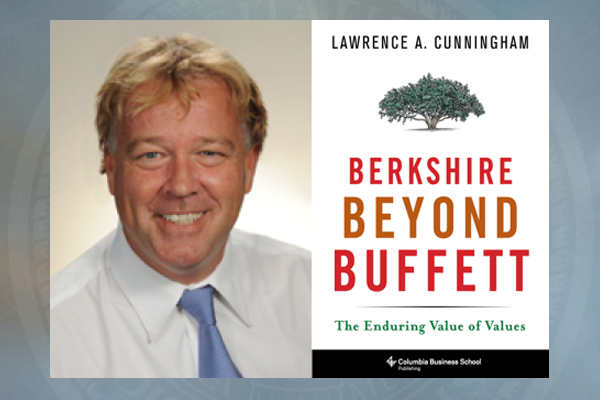Berkshire Hathaway, the $300 billion conglomerate that Warren Buffett built, is among the world’s largest and most famous corporations. Yet, for all its power and celebrity, few people understand Berkshire, and many assume it cannot survive without Buffett. A new book by Lawrence Cunningham, Berkshire Beyond Buffett, proves them wrong. www.berkshirebeyondbuffett.com.
In a comprehensive portrait of the corporate culture that unites Berkshire’s subsidiaries, Cunningham unearths the traits that assure the conglomerate’s perpetual prosperity. Riveting stories of each subsidiary’s origins, triumphs, and journey to Berkshire reveal how managers generate economic value from intangibles like thrift, integrity, entrepreneurship, autonomy, and a sense of permanence.
Rich with lessons for those wishing to profit from the Berkshire model, this engaging book is a valuable read for entrepreneurs, business owners, managers, family business members and investors, and it makes an important resource for scholars of corporate stewardship. General readers will enjoy learning how an iconoclastic businessman transformed a struggling textile company into a corporate legacy.
Blessed by Buffett and based on interviews with Berkshire chief executives and other insiders, Berkshire Beyond Buffett provides new insights on the structure and future of the company. Cunningham, the editor and publisher since 1997 of The Essays of Warren Buffett: Lessons for Corporate America, tells riveting stories of Berkshire’s fifty most significant subsidiaries, to draw valuable takeaways about leadership, management, corporate culture, and succession.
Some of the highlights from the book include:
1. Warren Buffett rose to prominence as a stock picker in the 1980s and 1990s, with Berkshire Hathaway then consisting 80 percent of his chosen share holdings and 20 percent of businesses; in the past decade, the mix quietly flipped and, with Berkshire now 80 percent businesses and 20 percent stocks, Buffett will soon become most famous for building and managing one of history’s largest corporations, now employing 300,000 workers.
2. People perceive Berkshire’s vastness and diversity as a throw-back to the discredited conglomerate era of the 1970s and 1980s that proved such companies unsustainable; in reality, Berkshire is united by a set of core values that give its subsidiaries coherence, common purpose, and sustenance, ratifying this business model.
3. While it isn’t easy to see how corporate culture translates into business performance or measure results, the stories of fifty Berkshire subsidiaries reveal a pattern of success from norms of thrift, integrity, entrepreneurship, trust, and a sense of permanence.
4. People don’t think of Berkshire Hathaway as an orphanage for the corporate homeless, yet a dozen of its subsidiaries, once damaged by leveraged buyouts and serial corporate parents with short-term outlooks, now prosper in Berkshire’s congenial culture that is averse to debt and adopts a long-term view.
5. Cynics doubt that big corporations can both make money and do good, but Berkshire’s subsidiaries routinely profit from virtue, whether GEICO passing on savings to customers, RC Willey furniture stores warranting merchandise out of its own pocket, or low-income housing supplier Clayton Homes assuring that customers can afford the homes they buy.
6. Skeptics warn that companies led by icons like Buffett cannot survive their passing, but Buffett’s greatest achievement is forging an institution larger than himself and designing it to outlast him. When people say, “Warren is so special that Berkshire can’t survive without him,” Cunningham counters with the book’s thesis: “Berkshire is, in fact, so special that it can thrive without Warren. That is his legacy.”
Prof. Lawrence Cunningham is a leading authority on Warren Buffett and Berkshire Hathaway and on corporate governance and culture. He is a Research Professor of Law at The George Washington University.





































